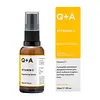What's inside
What's inside
 Key Ingredients
Key Ingredients

 Benefits
Benefits

 Concerns
Concerns

No concerns
 Ingredients Side-by-side
Ingredients Side-by-side

Aloe Barbadensis Leaf Juice
Skin ConditioningPropylene Glycol
HumectantWater
Skin ConditioningNiacinamide
SmoothingBetaine
HumectantGlycerin
HumectantPentylene Glycol
Skin ConditioningSodium Hyaluronate
HumectantAllantoin
Skin ConditioningBiosaccharide Gum-1
HumectantCucumis Melo Fruit Extract
Skin ConditioningLycium Barbarum Fruit Extract
AstringentPassiflora Edulis Fruit Extract
Skin ConditioningAnanas Sativus Fruit Extract
Skin ConditioningPrunus Persica Fruit Extract
AbrasiveCitrus Sinensis Fruit Extract
AntioxidantOryza Sativa Extract
AbsorbentCapparis Spinosa Fruit Extract
Skin ConditioningOlea Europaea Leaf Extract
PerfumingLonicera Caprifolium Flower Extract
PerfumingLonicera Japonica Flower Extract
Skin ConditioningMaltodextrin
AbsorbentXanthan Gum
EmulsifyingSodium Gluconate
Skin ConditioningPhenoxyethanol
PreservativeAloe Barbadensis Leaf Juice, Propylene Glycol, Water, Niacinamide, Betaine, Glycerin, Pentylene Glycol, Sodium Hyaluronate, Allantoin, Biosaccharide Gum-1, Cucumis Melo Fruit Extract, Lycium Barbarum Fruit Extract, Passiflora Edulis Fruit Extract, Ananas Sativus Fruit Extract, Prunus Persica Fruit Extract, Citrus Sinensis Fruit Extract, Oryza Sativa Extract, Capparis Spinosa Fruit Extract, Olea Europaea Leaf Extract, Lonicera Caprifolium Flower Extract, Lonicera Japonica Flower Extract, Maltodextrin, Xanthan Gum, Sodium Gluconate, Phenoxyethanol
Ingredients Explained
These ingredients are found in both products.
Ingredients higher up in an ingredient list are typically present in a larger amount.
Glycerin is already naturally found in your skin. It helps moisturize and protect your skin.
A study from 2016 found glycerin to be more effective as a humectant than AHAs and hyaluronic acid.
As a humectant, it helps the skin stay hydrated by pulling moisture to your skin. The low molecular weight of glycerin allows it to pull moisture into the deeper layers of your skin.
Hydrated skin improves your skin barrier; Your skin barrier helps protect against irritants and bacteria.
Glycerin has also been found to have antimicrobial and antiviral properties. Due to these properties, glycerin is often used in wound and burn treatments.
In cosmetics, glycerin is usually derived from plants such as soybean or palm. However, it can also be sourced from animals, such as tallow or animal fat.
This ingredient is organic, colorless, odorless, and non-toxic.
Glycerin is the name for this ingredient in American English. British English uses Glycerol/Glycerine.
Learn more about GlycerinPhenoxyethanol is a preservative that has germicide, antimicrobial, and aromatic properties. Studies show that phenoxyethanol can prevent microbial growth. By itself, it has a scent that is similar to that of a rose.
It's often used in formulations along with Caprylyl Glycol to preserve the shelf life of products.
Water. It's the most common cosmetic ingredient of all. You'll usually see it at the top of ingredient lists, meaning that it makes up the largest part of the product.
So why is it so popular? Water most often acts as a solvent - this means that it helps dissolve other ingredients into the formulation.
You'll also recognize water as that liquid we all need to stay alive. If you see this, drink a glass of water. Stay hydrated!
Learn more about Water